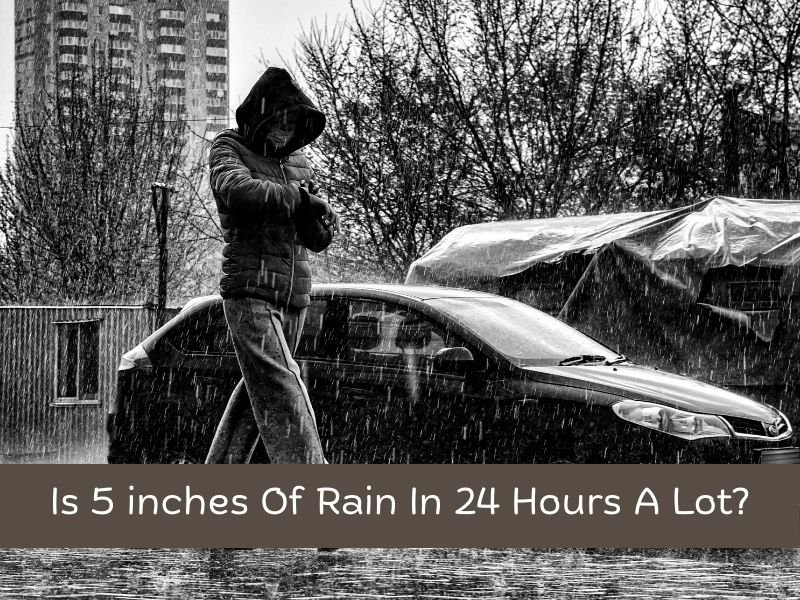In recent times, various regions worldwide have grappled with the consequences of intense rainfall. For instance, in May 2025, parts of Guwahati experienced severe waterlogging due to heavy overnight rainfall, disrupting transportation and education. Similarly, in the United States, areas like Albemarle County, Virginia, faced tragic outcomes from sudden downpours. These events underscore the significance of understanding rainfall measurements and their potential impacts.
Defining Heavy Rainfall
Rainfall intensity is typically measured in inches per hour. The National Weather Service (NWS) defines heavy rainfall as precipitation accumulating at a rate of 0.3 inches per hour or more. This classification helps in assessing potential flood risks and issuing timely warnings.
To put this into perspective, a rainfall rate of 0.3 inches per hour sustained over 24 hours would result in 7.2 inches of rain, which is substantial. Therefore, 5 inches of rain in a day is indeed significant and can lead to various challenges, especially in areas with inadequate drainage systems.
Contextualizing 5 Inches of Rain
Five inches of rain over 24 hours translates to a considerable volume of water. For example, in Skiatook, Oklahoma, such an amount led to widespread flooding, affecting daily life and infrastructure. While some residents considered it less severe compared to past events, the impact was still notable.
In another instance, the 2018 Hawaii floods saw record-breaking rainfall, with some areas receiving up to 49.69 inches in 24 hours. While this is an extreme case, it highlights how varying amounts of rainfall can have different effects based on regional factors.
Factors Influencing Impact
Several elements determine how impactful a specific amount of rainfall can be:
- Geographical Variations: Urban areas with impervious surfaces like concrete can experience more runoff, leading to flooding. In contrast, rural areas with absorbent soils might handle the same amount of rain differently.
- Soil Saturation and Topography: If the ground is already saturated from previous rains, additional rainfall can quickly lead to flooding. Similarly, regions with certain topographical features, like valleys, can be more prone to accumulating water.
Real-World Impacts of Similar Rainfall Events
In May 2025, Virginia experienced severe flooding after receiving 3 to 5 inches of rain, leading to tragic incidents and widespread evacuations. Similarly, parts of Bengaluru faced chaos due to heavy rainfall, resulting in waterlogging and traffic disruptions. These examples illustrate how even moderate amounts of rain can have significant consequences, especially in areas unprepared for such events.
Preparing for Heavy Rainfall
Preparation is crucial in mitigating the adverse effects of heavy rainfall:
- Infrastructure and Planning: Investing in robust drainage systems and urban planning can help manage excess water. Regular maintenance of these systems ensures they function effectively during heavy rains.
- Personal Preparedness: Individuals should stay informed through weather alerts and have emergency plans in place. Understanding the difference between various flood warnings can aid in timely responses.
Continuing the Article: Is 5 Inches of Rain in 24 Hours a Lot?
Understanding How Infrastructure Affects Flood Response
Modern cities face a unique challenge when it comes to managing rainfall. Urban environments are often dominated by impervious surfaces like asphalt, concrete, and rooftops that prevent water from seeping into the ground. As a result, even moderate rainfall can overwhelm drainage systems if they’re not properly maintained or designed for high-capacity flow.
For example, the U.S. Environmental Protection Agency (EPA) notes that poorly managed stormwater systems can lead to combined sewer overflows (CSOs), where raw sewage mixes with stormwater and floods urban areas or enters natural water bodies. (EPA Stormwater Management) These issues can be exacerbated during heavy rainfall events such as a 5-inch downpour within a single day.
Cities like Amsterdam and Singapore have invested heavily in sustainable urban drainage systems (SUDS) and underground stormwater tanks to mitigate such risks. In contrast, many cities in developing countries face budgetary or planning constraints, leading to higher vulnerability during extreme weather events.
How Climate Change Is Shifting Rainfall Norms
It’s important to note that 5 inches of rain in 24 hours may have been considered rare in many parts of the world in the past—but not anymore. According to data from the Intergovernmental Panel on Climate Change (IPCC), global warming is intensifying precipitation extremes. Warmer air holds more moisture, which leads to heavier downpours when that moisture condenses and falls as rain.
In the United States, NOAA’s Climate Science Special Report observed that the heaviest 1% of rainfall events have become 55% more intense in the Northeast since the 1950s. (NOAA Climate Science Report) This means that what was once considered an unusually large amount of rain—like 5 inches in one day—is becoming more frequent and potentially more damaging, especially in areas unprepared for such events.
Historical Precedents and Statistical Risk
Statistically, a rainfall event delivering 5 inches in 24 hours might be considered a “1 in 10-year” or even “1 in 25-year” event, depending on the region. The U.S. Geological Survey (USGS) provides recurrence interval estimates to help communities prepare for such possibilities. These intervals indicate how likely a certain amount of rainfall is to occur in any given year.
For instance, in New Jersey, a 5-inch rainfall event may statistically occur once every 25 years, while in wetter regions like Louisiana, it may be a once-every-5-years event. These estimates are crucial for zoning decisions, insurance policies, and infrastructure planning.
Impact on Agriculture and Ecosystems
It’s not just urban areas that suffer. In agricultural regions, 5 inches of rain in a single day can result in crop damage, soil erosion, and nutrient runoff. Saturated fields may inhibit planting or harvest schedules, while excessive water can cause root rot or fungal infections.
According to the U.S. Department of Agriculture (USDA), erosion from intense rainfall events can strip the topsoil, degrading the land’s productivity over time. (USDA Soil Health) Furthermore, the runoff often carries pesticides, fertilizers, and waste into nearby rivers and lakes, affecting water quality and aquatic life.
Forests and natural ecosystems aren’t immune either. Sudden heavy rains can cause landslides on forested slopes or wash away habitats in low-lying wetlands. These effects compound environmental stress already induced by shifting climate patterns.
Insurance, Risk, and Economic Consequences
From an economic perspective, rainfall events like this can have ripple effects far beyond the immediate flood zone. The National Flood Insurance Program (NFIP) notes that just one inch of floodwater can cause over $25,000 in damage to a home. Five inches—particularly if accompanied by runoff or sewage backups—can cause exponentially greater harm.
Moreover, businesses forced to close due to flooding may suffer lost revenue, and supply chains can be disrupted, leading to regional or even national economic implications. In 2021, flooding in Germany caused over €33 billion in damages, demonstrating the potential financial toll of similar precipitation events in developed economies.
Emergency Response and Community Resilience
To manage these risks, cities and governments are increasingly investing in early warning systems and community resilience strategies. Tools like Doppler radar and real-time satellite imagery have improved rainfall predictions, enabling faster emergency responses.
Organisations such as the Federal Emergency Management Agency (FEMA) and the Red Cross emphasize the importance of flood preparedness, including securing important documents, planning evacuation routes, and understanding the difference between a flood watch and a flood warning.
Local community engagement is also vital. Programs that train volunteers in emergency response (like CERT in the U.S.) and initiatives that support flood-proof building practices can dramatically reduce the impact of such rainfall events.
Looking Ahead: A New Normal?
With rainfall extremes becoming more frequent, the question isn’t just whether 5 inches in 24 hours is a lot—it’s whether we’re adequately prepared to handle such events. What was once exceptional may soon be routine in some parts of the world.
Governments, urban planners, insurers, and citizens must adapt to this new reality. This includes revising building codes, updating floodplain maps, increasing green infrastructure, and investing in public awareness campaigns.
The future demands more than recognition—it demands resilience.
Final Thoughts
Ultimately, while 5 inches of rain in 24 hours might not break historical records, it remains a significant meteorological and societal event. Its consequences—ranging from minor inconveniences to catastrophic flooding—highlight the importance of regional context, preparedness, and evolving climate patterns.
As extreme weather continues to intensify, society’s ability to understand and respond to heavy rainfall will be key to minimizing damage and protecting lives. Knowledge, preparation, and investment today can make all the difference tomorrow.






